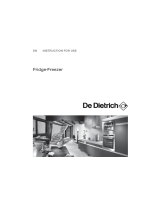
3
Instructions for Use
Important
Mounting Instructions
Integrated appliances are equipped with
instructions for mounting the appliance into
the kitchen unit. The appliance should be
professionally mounted by qualifi ed technician
and instructions are for his use only.
We Care for the Environment
• Our appliances are distributed in packaging
made of environmental friendly material
which could safely be recycled, disposed
off or destroyed, with no effects on the
nature whatsoever.
• These instructions are printed either on
recycled paper or chlorine free bleached
paper.
• When your appliance finally wears out,
please try not to burden the environment
with it; call your nearest authorised service
agent. (See Disposing of the Worn Out
Appliance).
Tips for Energy Savings
• Try not to open the door too often, especially
when the weather is wet and hot. Once you
open the door, mind to close it as soon as
possible. This is especially important if you
have an upright model.
• Every now and then check if the appliance is
sufficiently ventilated (adequate air circulation
behind the appliance).
• Use higher thermostat settings only when
required or recommended.
• Before loading the appliance with packages
of fresh foods, make sure they are cooled to
ambient temperature.
• Ice and frost layer increase energy
consumption, so do clean the appliance as
soon as the layer is 3-5 mm thick.
• If the gasket is damaged or if it turns out that
the sealing is poor, the energy consumption
is substantially higher. To restore efficiency,
replace the gasket.
• The condenser on the rear wall should be
always clean, free of dust or any impurities.
• Always consider instructions stated in
sections Positioning and Energy Saving
Tips, otherwise the energy consumption is
substantially higher.
• This appliance can be used by children
aged from 8 years and above and
persons with reduced physical, sensory
or metal capabilities or lack of experience
and knowledge if they have been given
supervision or instruction concerning use of
the appliance in a safe way and understand
the hazards involved. Children shall not
play with the appliance. Cleaning and user
maintenance shall not be made by children
without supervision.
• If you have bought this appliance to replace
an old one equipped with a lock that cannot
be opened from inside (lock, bolt), make
sure that the lock is broken. This will make
it impossible for children to lock themselves
inside the appliance and suffocate.
• The appliance must be correctly connected
to the mains supply. (see: Connecting to
the Mains Supply).
• Do not touch the cooled surfaces while the
appliance operates, especially not with wet
hands, because the skin may stick to the
cold surfaces.
• Do not freeze bottles containing liquid,
especially not soft drinks, such as mineral
water, sparkling wine, beer, cola etc.,
because liquid expands during freezing and
the glass bottle is very likely to blow up.
• Do not eat frozen food (bread, fruit,
vegetables), because you can get
frostbites.
• If the food has strange smell or color, throw
it away, because it is very likely that it is
spoiled and therefore dangerous to eat.
• Disconnect the appliance from the power
supply before repairing it (only a qualified
technician should repair it), before cleaning
and before replacing the light bulb.
• Do not defrost the appliance with other
electric appliances (as for example with
hair dryer) and never scrape the frost layer
with sharp objects. Use only enclosed tools
or tools recommended by the manufacturer.













